Detailed Report: Managing Quality and Customer Service in Business
VerifiedAdded on 2021/01/02
|17
|4569
|143
Report
AI Summary
This report delves into the critical aspects of quality and customer service management within a business context. It begins by defining a customer-driven organization and explores the needs, wants, and requirements of customers, including market segmentation and the role of the supply chain. The report then examines the characteristics of good managers and the concept of value-added selling. It differentiates between customer needs, wants, and requirements, and discusses the application of these concepts in business planning. Further, the report investigates areas where commercial organizations achieve success, methods for identifying service problems, and the skills needed to meet customer expectations. It also covers strategies for gaining and retaining customer loyalty, the relationship between profits, customer satisfaction, and organizational success, and the identification of strategies to address sales decline. Overall, the report provides a comprehensive overview of the key elements of quality and customer service, offering valuable insights for businesses seeking to enhance customer satisfaction and achieve sustainable success.
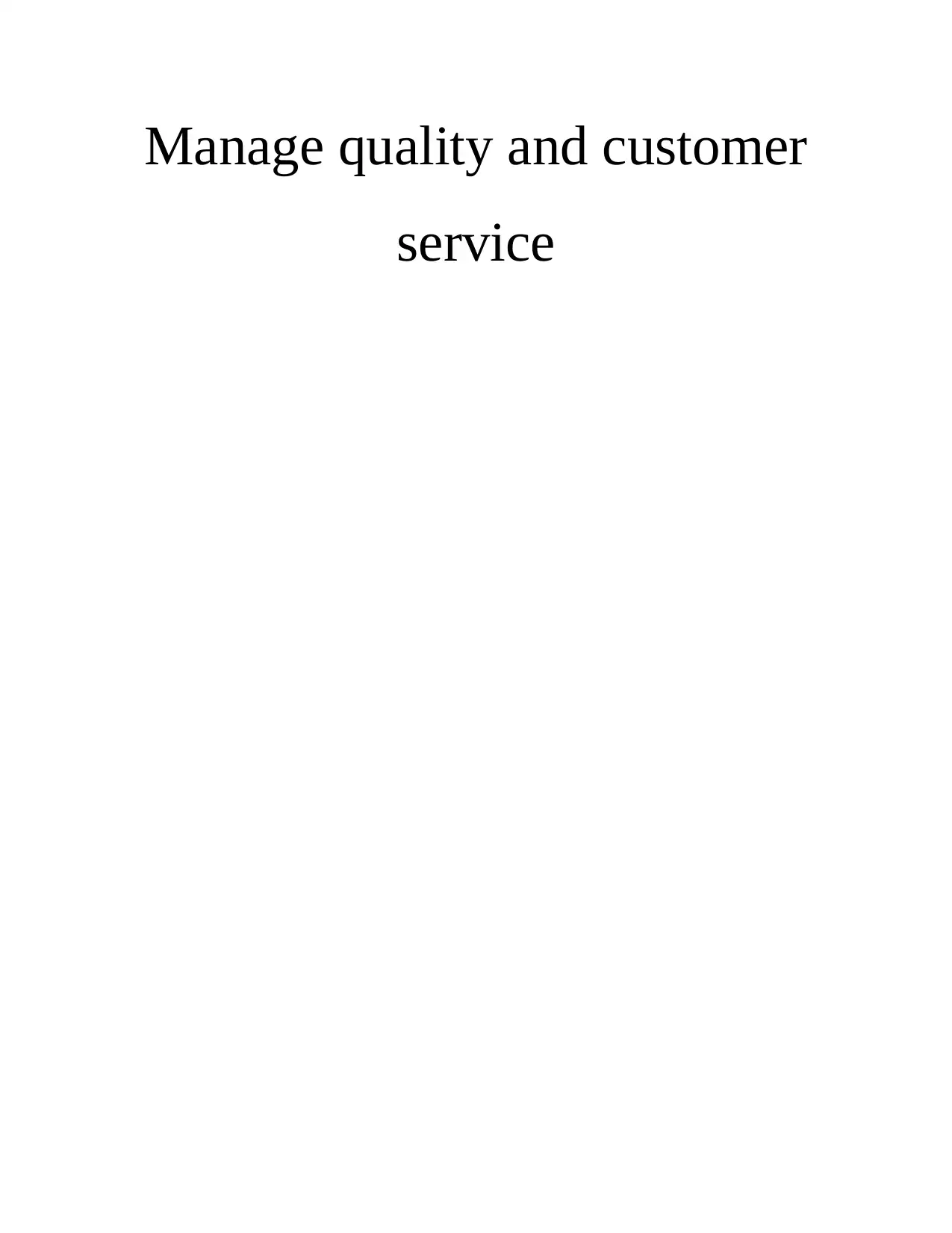
Manage quality and customer
service
service
Paraphrase This Document
Need a fresh take? Get an instant paraphrase of this document with our AI Paraphraser
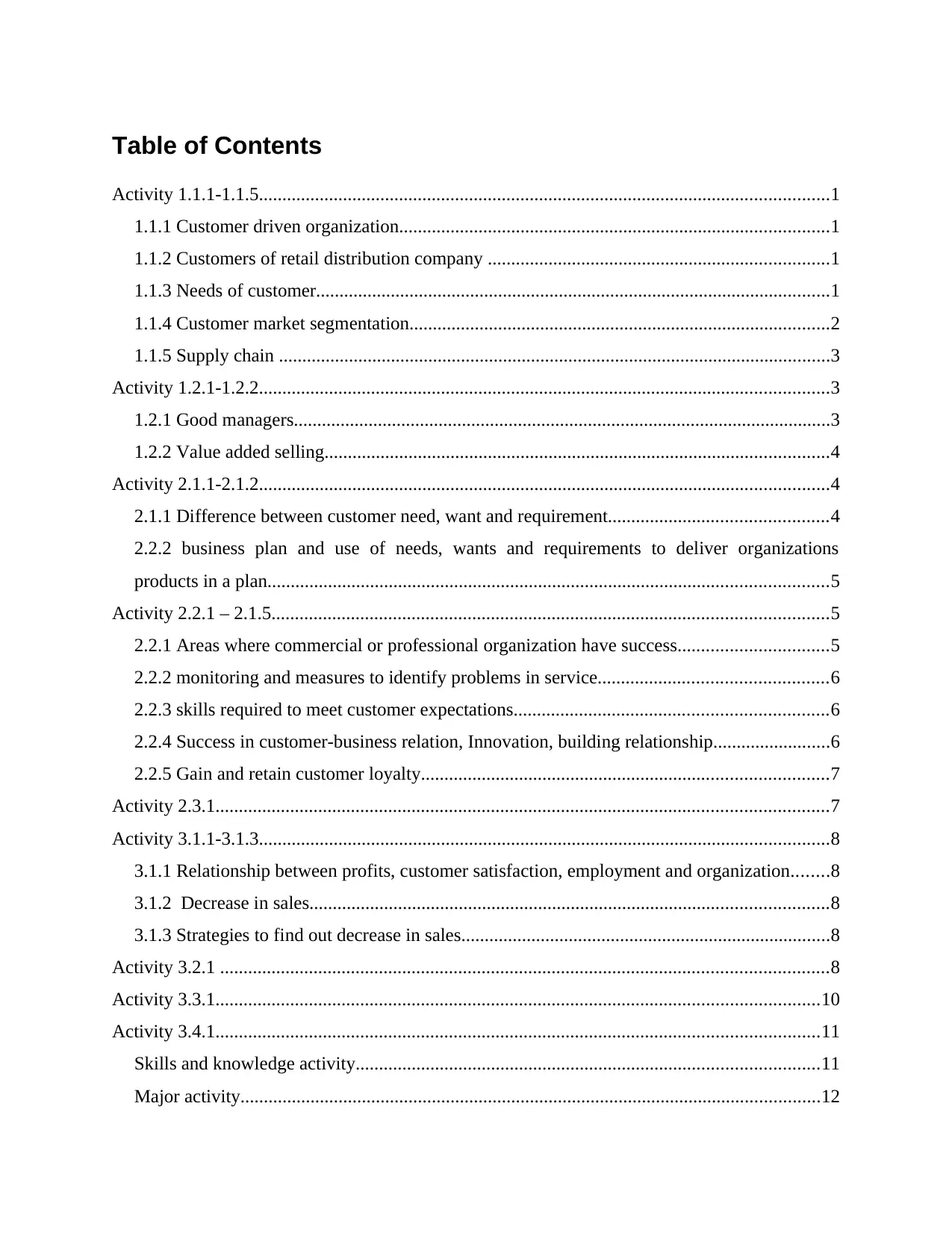
Table of Contents
Activity 1.1.1-1.1.5..........................................................................................................................1
1.1.1 Customer driven organization............................................................................................1
1.1.2 Customers of retail distribution company .........................................................................1
1.1.3 Needs of customer..............................................................................................................1
1.1.4 Customer market segmentation..........................................................................................2
1.1.5 Supply chain ......................................................................................................................3
Activity 1.2.1-1.2.2..........................................................................................................................3
1.2.1 Good managers...................................................................................................................3
1.2.2 Value added selling............................................................................................................4
Activity 2.1.1-2.1.2..........................................................................................................................4
2.1.1 Difference between customer need, want and requirement...............................................4
2.2.2 business plan and use of needs, wants and requirements to deliver organizations
products in a plan........................................................................................................................5
Activity 2.2.1 – 2.1.5.......................................................................................................................5
2.2.1 Areas where commercial or professional organization have success................................5
2.2.2 monitoring and measures to identify problems in service.................................................6
2.2.3 skills required to meet customer expectations...................................................................6
2.2.4 Success in customer-business relation, Innovation, building relationship.........................6
2.2.5 Gain and retain customer loyalty.......................................................................................7
Activity 2.3.1...................................................................................................................................7
Activity 3.1.1-3.1.3..........................................................................................................................8
3.1.1 Relationship between profits, customer satisfaction, employment and organization........8
3.1.2 Decrease in sales...............................................................................................................8
3.1.3 Strategies to find out decrease in sales...............................................................................8
Activity 3.2.1 ..................................................................................................................................8
Activity 3.3.1.................................................................................................................................10
Activity 3.4.1.................................................................................................................................11
Skills and knowledge activity...................................................................................................11
Major activity............................................................................................................................12
Activity 1.1.1-1.1.5..........................................................................................................................1
1.1.1 Customer driven organization............................................................................................1
1.1.2 Customers of retail distribution company .........................................................................1
1.1.3 Needs of customer..............................................................................................................1
1.1.4 Customer market segmentation..........................................................................................2
1.1.5 Supply chain ......................................................................................................................3
Activity 1.2.1-1.2.2..........................................................................................................................3
1.2.1 Good managers...................................................................................................................3
1.2.2 Value added selling............................................................................................................4
Activity 2.1.1-2.1.2..........................................................................................................................4
2.1.1 Difference between customer need, want and requirement...............................................4
2.2.2 business plan and use of needs, wants and requirements to deliver organizations
products in a plan........................................................................................................................5
Activity 2.2.1 – 2.1.5.......................................................................................................................5
2.2.1 Areas where commercial or professional organization have success................................5
2.2.2 monitoring and measures to identify problems in service.................................................6
2.2.3 skills required to meet customer expectations...................................................................6
2.2.4 Success in customer-business relation, Innovation, building relationship.........................6
2.2.5 Gain and retain customer loyalty.......................................................................................7
Activity 2.3.1...................................................................................................................................7
Activity 3.1.1-3.1.3..........................................................................................................................8
3.1.1 Relationship between profits, customer satisfaction, employment and organization........8
3.1.2 Decrease in sales...............................................................................................................8
3.1.3 Strategies to find out decrease in sales...............................................................................8
Activity 3.2.1 ..................................................................................................................................8
Activity 3.3.1.................................................................................................................................10
Activity 3.4.1.................................................................................................................................11
Skills and knowledge activity...................................................................................................11
Major activity............................................................................................................................12

REFERENCES..............................................................................................................................13
⊘ This is a preview!⊘
Do you want full access?
Subscribe today to unlock all pages.

Trusted by 1+ million students worldwide
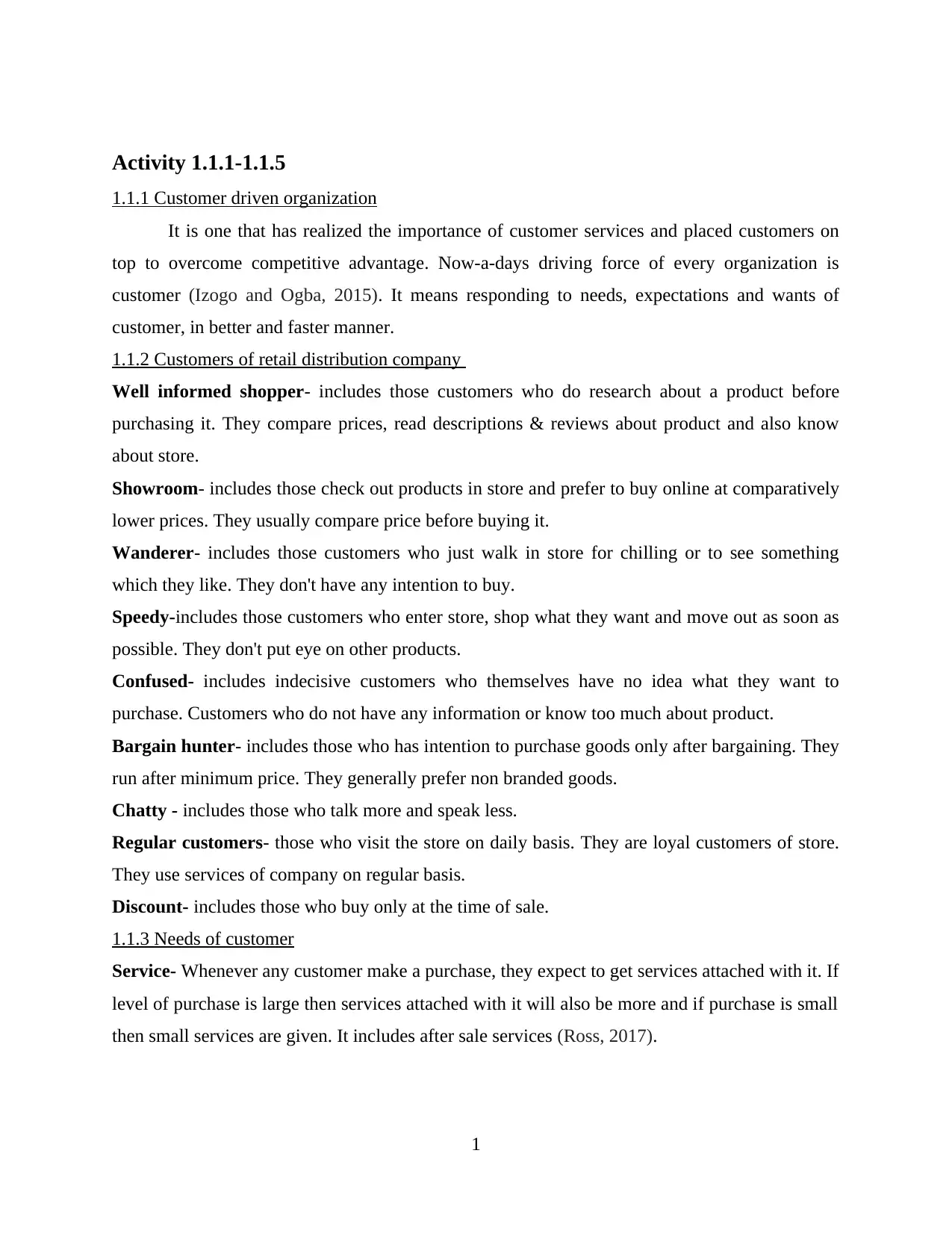
Activity 1.1.1-1.1.5
1.1.1 Customer driven organization
It is one that has realized the importance of customer services and placed customers on
top to overcome competitive advantage. Now-a-days driving force of every organization is
customer (Izogo and Ogba, 2015). It means responding to needs, expectations and wants of
customer, in better and faster manner.
1.1.2 Customers of retail distribution company
Well informed shopper- includes those customers who do research about a product before
purchasing it. They compare prices, read descriptions & reviews about product and also know
about store.
Showroom- includes those check out products in store and prefer to buy online at comparatively
lower prices. They usually compare price before buying it.
Wanderer- includes those customers who just walk in store for chilling or to see something
which they like. They don't have any intention to buy.
Speedy-includes those customers who enter store, shop what they want and move out as soon as
possible. They don't put eye on other products.
Confused- includes indecisive customers who themselves have no idea what they want to
purchase. Customers who do not have any information or know too much about product.
Bargain hunter- includes those who has intention to purchase goods only after bargaining. They
run after minimum price. They generally prefer non branded goods.
Chatty - includes those who talk more and speak less.
Regular customers- those who visit the store on daily basis. They are loyal customers of store.
They use services of company on regular basis.
Discount- includes those who buy only at the time of sale.
1.1.3 Needs of customer
Service- Whenever any customer make a purchase, they expect to get services attached with it. If
level of purchase is large then services attached with it will also be more and if purchase is small
then small services are given. It includes after sale services (Ross, 2017).
1
1.1.1 Customer driven organization
It is one that has realized the importance of customer services and placed customers on
top to overcome competitive advantage. Now-a-days driving force of every organization is
customer (Izogo and Ogba, 2015). It means responding to needs, expectations and wants of
customer, in better and faster manner.
1.1.2 Customers of retail distribution company
Well informed shopper- includes those customers who do research about a product before
purchasing it. They compare prices, read descriptions & reviews about product and also know
about store.
Showroom- includes those check out products in store and prefer to buy online at comparatively
lower prices. They usually compare price before buying it.
Wanderer- includes those customers who just walk in store for chilling or to see something
which they like. They don't have any intention to buy.
Speedy-includes those customers who enter store, shop what they want and move out as soon as
possible. They don't put eye on other products.
Confused- includes indecisive customers who themselves have no idea what they want to
purchase. Customers who do not have any information or know too much about product.
Bargain hunter- includes those who has intention to purchase goods only after bargaining. They
run after minimum price. They generally prefer non branded goods.
Chatty - includes those who talk more and speak less.
Regular customers- those who visit the store on daily basis. They are loyal customers of store.
They use services of company on regular basis.
Discount- includes those who buy only at the time of sale.
1.1.3 Needs of customer
Service- Whenever any customer make a purchase, they expect to get services attached with it. If
level of purchase is large then services attached with it will also be more and if purchase is small
then small services are given. It includes after sale services (Ross, 2017).
1
Paraphrase This Document
Need a fresh take? Get an instant paraphrase of this document with our AI Paraphraser
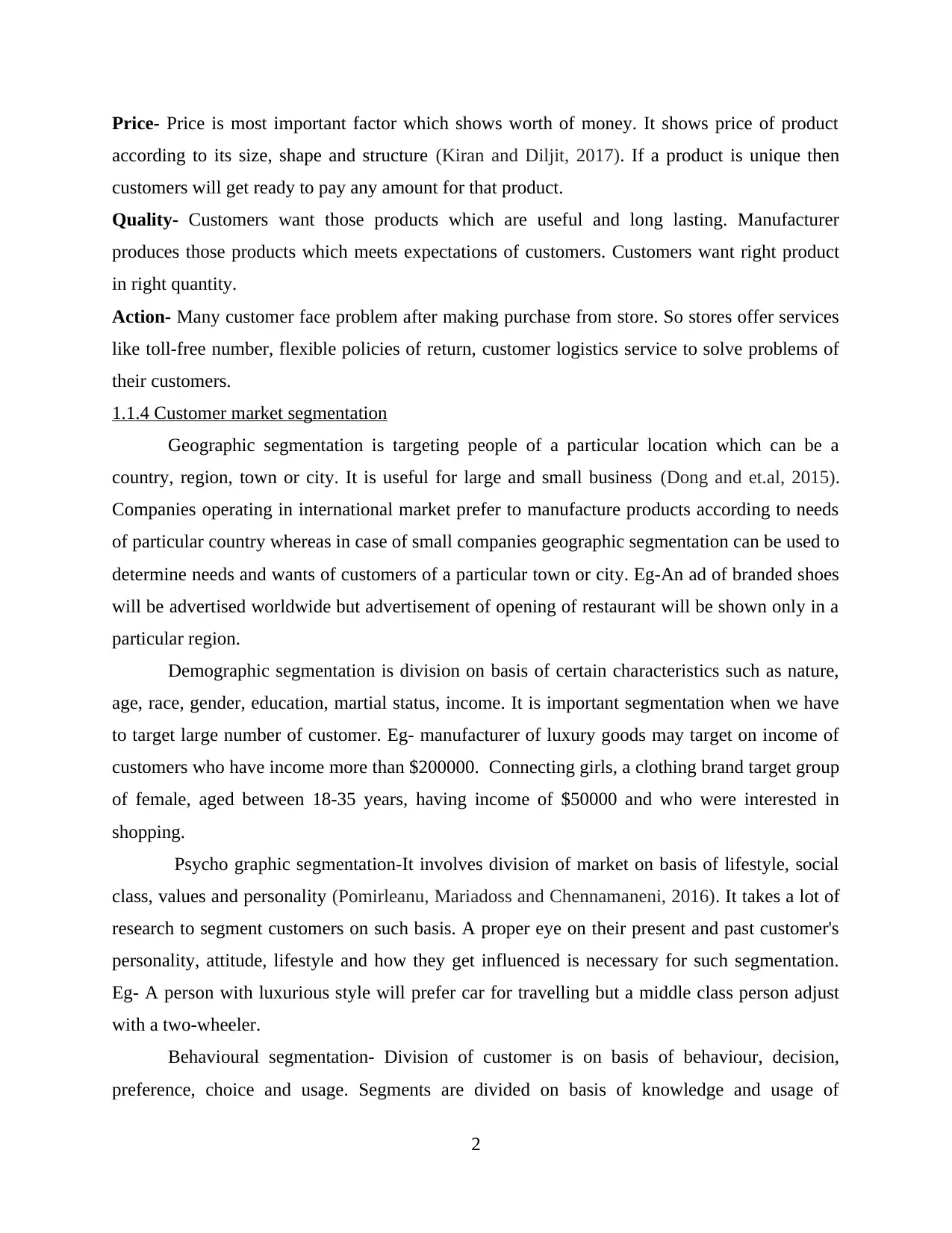
Price- Price is most important factor which shows worth of money. It shows price of product
according to its size, shape and structure (Kiran and Diljit, 2017). If a product is unique then
customers will get ready to pay any amount for that product.
Quality- Customers want those products which are useful and long lasting. Manufacturer
produces those products which meets expectations of customers. Customers want right product
in right quantity.
Action- Many customer face problem after making purchase from store. So stores offer services
like toll-free number, flexible policies of return, customer logistics service to solve problems of
their customers.
1.1.4 Customer market segmentation
Geographic segmentation is targeting people of a particular location which can be a
country, region, town or city. It is useful for large and small business (Dong and et.al, 2015).
Companies operating in international market prefer to manufacture products according to needs
of particular country whereas in case of small companies geographic segmentation can be used to
determine needs and wants of customers of a particular town or city. Eg-An ad of branded shoes
will be advertised worldwide but advertisement of opening of restaurant will be shown only in a
particular region.
Demographic segmentation is division on basis of certain characteristics such as nature,
age, race, gender, education, martial status, income. It is important segmentation when we have
to target large number of customer. Eg- manufacturer of luxury goods may target on income of
customers who have income more than $200000. Connecting girls, a clothing brand target group
of female, aged between 18-35 years, having income of $50000 and who were interested in
shopping.
Psycho graphic segmentation-It involves division of market on basis of lifestyle, social
class, values and personality (Pomirleanu, Mariadoss and Chennamaneni, 2016). It takes a lot of
research to segment customers on such basis. A proper eye on their present and past customer's
personality, attitude, lifestyle and how they get influenced is necessary for such segmentation.
Eg- A person with luxurious style will prefer car for travelling but a middle class person adjust
with a two-wheeler.
Behavioural segmentation- Division of customer is on basis of behaviour, decision,
preference, choice and usage. Segments are divided on basis of knowledge and usage of
2
according to its size, shape and structure (Kiran and Diljit, 2017). If a product is unique then
customers will get ready to pay any amount for that product.
Quality- Customers want those products which are useful and long lasting. Manufacturer
produces those products which meets expectations of customers. Customers want right product
in right quantity.
Action- Many customer face problem after making purchase from store. So stores offer services
like toll-free number, flexible policies of return, customer logistics service to solve problems of
their customers.
1.1.4 Customer market segmentation
Geographic segmentation is targeting people of a particular location which can be a
country, region, town or city. It is useful for large and small business (Dong and et.al, 2015).
Companies operating in international market prefer to manufacture products according to needs
of particular country whereas in case of small companies geographic segmentation can be used to
determine needs and wants of customers of a particular town or city. Eg-An ad of branded shoes
will be advertised worldwide but advertisement of opening of restaurant will be shown only in a
particular region.
Demographic segmentation is division on basis of certain characteristics such as nature,
age, race, gender, education, martial status, income. It is important segmentation when we have
to target large number of customer. Eg- manufacturer of luxury goods may target on income of
customers who have income more than $200000. Connecting girls, a clothing brand target group
of female, aged between 18-35 years, having income of $50000 and who were interested in
shopping.
Psycho graphic segmentation-It involves division of market on basis of lifestyle, social
class, values and personality (Pomirleanu, Mariadoss and Chennamaneni, 2016). It takes a lot of
research to segment customers on such basis. A proper eye on their present and past customer's
personality, attitude, lifestyle and how they get influenced is necessary for such segmentation.
Eg- A person with luxurious style will prefer car for travelling but a middle class person adjust
with a two-wheeler.
Behavioural segmentation- Division of customer is on basis of behaviour, decision,
preference, choice and usage. Segments are divided on basis of knowledge and usage of
2
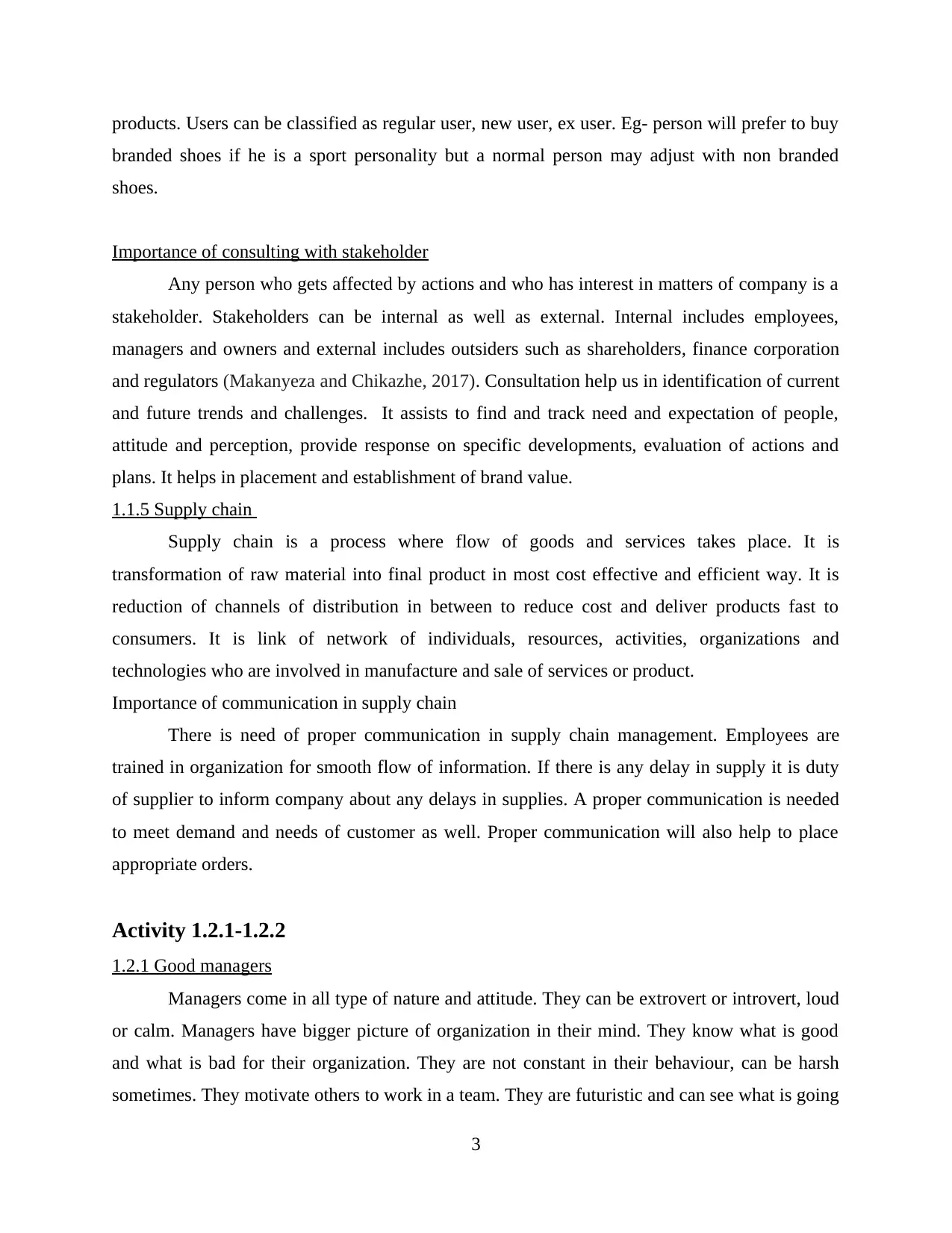
products. Users can be classified as regular user, new user, ex user. Eg- person will prefer to buy
branded shoes if he is a sport personality but a normal person may adjust with non branded
shoes.
Importance of consulting with stakeholder
Any person who gets affected by actions and who has interest in matters of company is a
stakeholder. Stakeholders can be internal as well as external. Internal includes employees,
managers and owners and external includes outsiders such as shareholders, finance corporation
and regulators (Makanyeza and Chikazhe, 2017). Consultation help us in identification of current
and future trends and challenges. It assists to find and track need and expectation of people,
attitude and perception, provide response on specific developments, evaluation of actions and
plans. It helps in placement and establishment of brand value.
1.1.5 Supply chain
Supply chain is a process where flow of goods and services takes place. It is
transformation of raw material into final product in most cost effective and efficient way. It is
reduction of channels of distribution in between to reduce cost and deliver products fast to
consumers. It is link of network of individuals, resources, activities, organizations and
technologies who are involved in manufacture and sale of services or product.
Importance of communication in supply chain
There is need of proper communication in supply chain management. Employees are
trained in organization for smooth flow of information. If there is any delay in supply it is duty
of supplier to inform company about any delays in supplies. A proper communication is needed
to meet demand and needs of customer as well. Proper communication will also help to place
appropriate orders.
Activity 1.2.1-1.2.2
1.2.1 Good managers
Managers come in all type of nature and attitude. They can be extrovert or introvert, loud
or calm. Managers have bigger picture of organization in their mind. They know what is good
and what is bad for their organization. They are not constant in their behaviour, can be harsh
sometimes. They motivate others to work in a team. They are futuristic and can see what is going
3
branded shoes if he is a sport personality but a normal person may adjust with non branded
shoes.
Importance of consulting with stakeholder
Any person who gets affected by actions and who has interest in matters of company is a
stakeholder. Stakeholders can be internal as well as external. Internal includes employees,
managers and owners and external includes outsiders such as shareholders, finance corporation
and regulators (Makanyeza and Chikazhe, 2017). Consultation help us in identification of current
and future trends and challenges. It assists to find and track need and expectation of people,
attitude and perception, provide response on specific developments, evaluation of actions and
plans. It helps in placement and establishment of brand value.
1.1.5 Supply chain
Supply chain is a process where flow of goods and services takes place. It is
transformation of raw material into final product in most cost effective and efficient way. It is
reduction of channels of distribution in between to reduce cost and deliver products fast to
consumers. It is link of network of individuals, resources, activities, organizations and
technologies who are involved in manufacture and sale of services or product.
Importance of communication in supply chain
There is need of proper communication in supply chain management. Employees are
trained in organization for smooth flow of information. If there is any delay in supply it is duty
of supplier to inform company about any delays in supplies. A proper communication is needed
to meet demand and needs of customer as well. Proper communication will also help to place
appropriate orders.
Activity 1.2.1-1.2.2
1.2.1 Good managers
Managers come in all type of nature and attitude. They can be extrovert or introvert, loud
or calm. Managers have bigger picture of organization in their mind. They know what is good
and what is bad for their organization. They are not constant in their behaviour, can be harsh
sometimes. They motivate others to work in a team. They are futuristic and can see what is going
3
⊘ This is a preview!⊘
Do you want full access?
Subscribe today to unlock all pages.

Trusted by 1+ million students worldwide
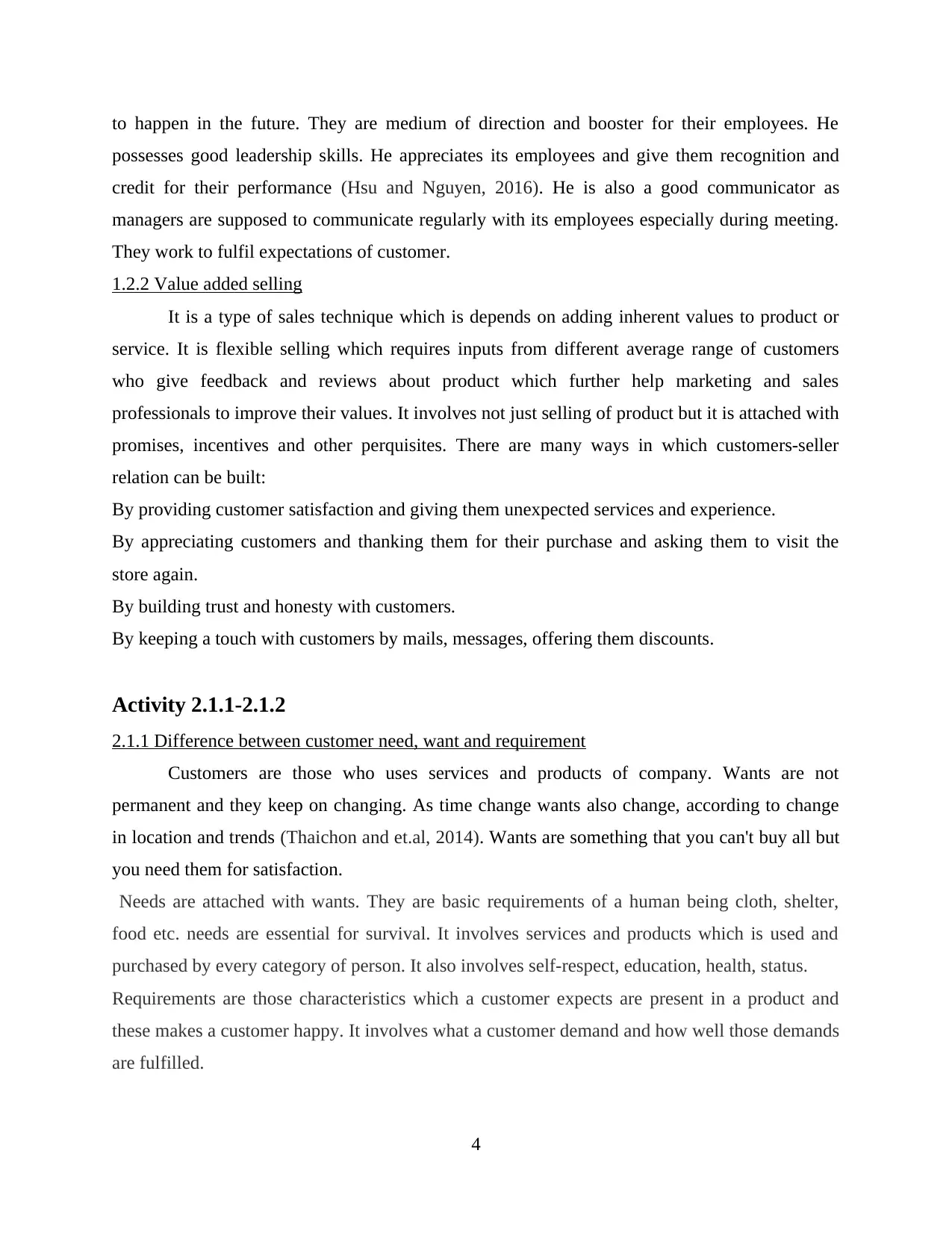
to happen in the future. They are medium of direction and booster for their employees. He
possesses good leadership skills. He appreciates its employees and give them recognition and
credit for their performance (Hsu and Nguyen, 2016). He is also a good communicator as
managers are supposed to communicate regularly with its employees especially during meeting.
They work to fulfil expectations of customer.
1.2.2 Value added selling
It is a type of sales technique which is depends on adding inherent values to product or
service. It is flexible selling which requires inputs from different average range of customers
who give feedback and reviews about product which further help marketing and sales
professionals to improve their values. It involves not just selling of product but it is attached with
promises, incentives and other perquisites. There are many ways in which customers-seller
relation can be built:
By providing customer satisfaction and giving them unexpected services and experience.
By appreciating customers and thanking them for their purchase and asking them to visit the
store again.
By building trust and honesty with customers.
By keeping a touch with customers by mails, messages, offering them discounts.
Activity 2.1.1-2.1.2
2.1.1 Difference between customer need, want and requirement
Customers are those who uses services and products of company. Wants are not
permanent and they keep on changing. As time change wants also change, according to change
in location and trends (Thaichon and et.al, 2014). Wants are something that you can't buy all but
you need them for satisfaction.
Needs are attached with wants. They are basic requirements of a human being cloth, shelter,
food etc. needs are essential for survival. It involves services and products which is used and
purchased by every category of person. It also involves self-respect, education, health, status.
Requirements are those characteristics which a customer expects are present in a product and
these makes a customer happy. It involves what a customer demand and how well those demands
are fulfilled.
4
possesses good leadership skills. He appreciates its employees and give them recognition and
credit for their performance (Hsu and Nguyen, 2016). He is also a good communicator as
managers are supposed to communicate regularly with its employees especially during meeting.
They work to fulfil expectations of customer.
1.2.2 Value added selling
It is a type of sales technique which is depends on adding inherent values to product or
service. It is flexible selling which requires inputs from different average range of customers
who give feedback and reviews about product which further help marketing and sales
professionals to improve their values. It involves not just selling of product but it is attached with
promises, incentives and other perquisites. There are many ways in which customers-seller
relation can be built:
By providing customer satisfaction and giving them unexpected services and experience.
By appreciating customers and thanking them for their purchase and asking them to visit the
store again.
By building trust and honesty with customers.
By keeping a touch with customers by mails, messages, offering them discounts.
Activity 2.1.1-2.1.2
2.1.1 Difference between customer need, want and requirement
Customers are those who uses services and products of company. Wants are not
permanent and they keep on changing. As time change wants also change, according to change
in location and trends (Thaichon and et.al, 2014). Wants are something that you can't buy all but
you need them for satisfaction.
Needs are attached with wants. They are basic requirements of a human being cloth, shelter,
food etc. needs are essential for survival. It involves services and products which is used and
purchased by every category of person. It also involves self-respect, education, health, status.
Requirements are those characteristics which a customer expects are present in a product and
these makes a customer happy. It involves what a customer demand and how well those demands
are fulfilled.
4
Paraphrase This Document
Need a fresh take? Get an instant paraphrase of this document with our AI Paraphraser
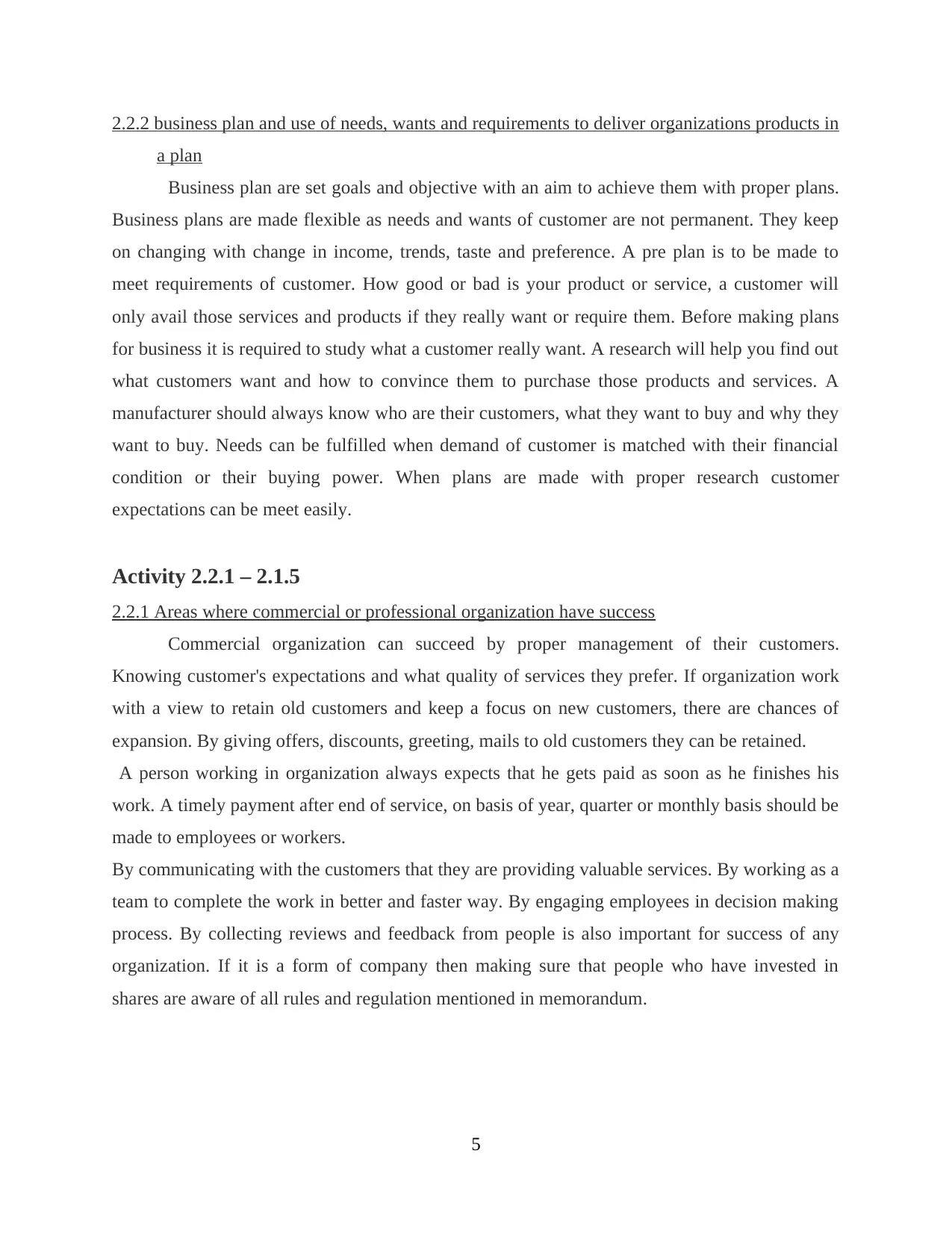
2.2.2 business plan and use of needs, wants and requirements to deliver organizations products in
a plan
Business plan are set goals and objective with an aim to achieve them with proper plans.
Business plans are made flexible as needs and wants of customer are not permanent. They keep
on changing with change in income, trends, taste and preference. A pre plan is to be made to
meet requirements of customer. How good or bad is your product or service, a customer will
only avail those services and products if they really want or require them. Before making plans
for business it is required to study what a customer really want. A research will help you find out
what customers want and how to convince them to purchase those products and services. A
manufacturer should always know who are their customers, what they want to buy and why they
want to buy. Needs can be fulfilled when demand of customer is matched with their financial
condition or their buying power. When plans are made with proper research customer
expectations can be meet easily.
Activity 2.2.1 – 2.1.5
2.2.1 Areas where commercial or professional organization have success
Commercial organization can succeed by proper management of their customers.
Knowing customer's expectations and what quality of services they prefer. If organization work
with a view to retain old customers and keep a focus on new customers, there are chances of
expansion. By giving offers, discounts, greeting, mails to old customers they can be retained.
A person working in organization always expects that he gets paid as soon as he finishes his
work. A timely payment after end of service, on basis of year, quarter or monthly basis should be
made to employees or workers.
By communicating with the customers that they are providing valuable services. By working as a
team to complete the work in better and faster way. By engaging employees in decision making
process. By collecting reviews and feedback from people is also important for success of any
organization. If it is a form of company then making sure that people who have invested in
shares are aware of all rules and regulation mentioned in memorandum.
5
a plan
Business plan are set goals and objective with an aim to achieve them with proper plans.
Business plans are made flexible as needs and wants of customer are not permanent. They keep
on changing with change in income, trends, taste and preference. A pre plan is to be made to
meet requirements of customer. How good or bad is your product or service, a customer will
only avail those services and products if they really want or require them. Before making plans
for business it is required to study what a customer really want. A research will help you find out
what customers want and how to convince them to purchase those products and services. A
manufacturer should always know who are their customers, what they want to buy and why they
want to buy. Needs can be fulfilled when demand of customer is matched with their financial
condition or their buying power. When plans are made with proper research customer
expectations can be meet easily.
Activity 2.2.1 – 2.1.5
2.2.1 Areas where commercial or professional organization have success
Commercial organization can succeed by proper management of their customers.
Knowing customer's expectations and what quality of services they prefer. If organization work
with a view to retain old customers and keep a focus on new customers, there are chances of
expansion. By giving offers, discounts, greeting, mails to old customers they can be retained.
A person working in organization always expects that he gets paid as soon as he finishes his
work. A timely payment after end of service, on basis of year, quarter or monthly basis should be
made to employees or workers.
By communicating with the customers that they are providing valuable services. By working as a
team to complete the work in better and faster way. By engaging employees in decision making
process. By collecting reviews and feedback from people is also important for success of any
organization. If it is a form of company then making sure that people who have invested in
shares are aware of all rules and regulation mentioned in memorandum.
5
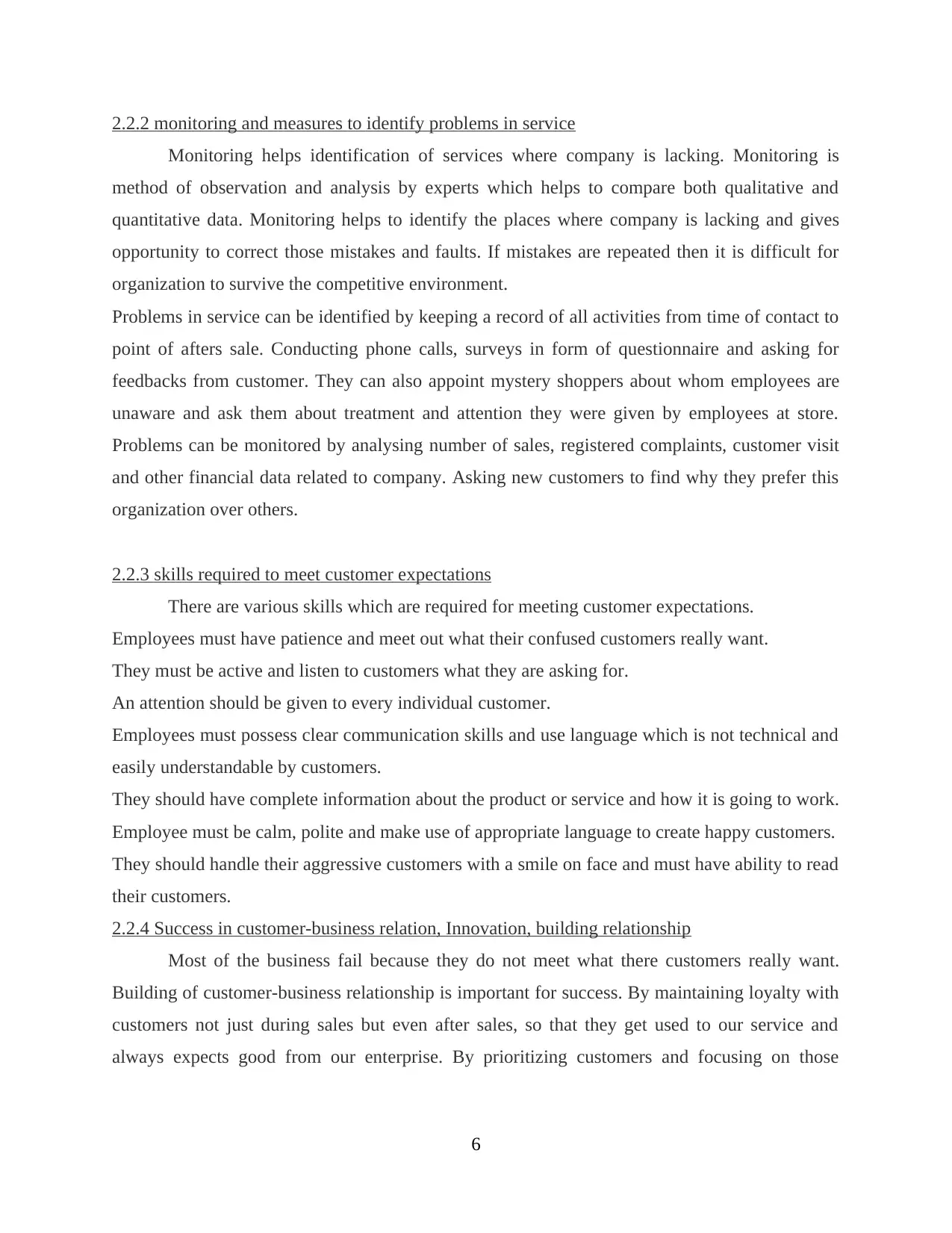
2.2.2 monitoring and measures to identify problems in service
Monitoring helps identification of services where company is lacking. Monitoring is
method of observation and analysis by experts which helps to compare both qualitative and
quantitative data. Monitoring helps to identify the places where company is lacking and gives
opportunity to correct those mistakes and faults. If mistakes are repeated then it is difficult for
organization to survive the competitive environment.
Problems in service can be identified by keeping a record of all activities from time of contact to
point of afters sale. Conducting phone calls, surveys in form of questionnaire and asking for
feedbacks from customer. They can also appoint mystery shoppers about whom employees are
unaware and ask them about treatment and attention they were given by employees at store.
Problems can be monitored by analysing number of sales, registered complaints, customer visit
and other financial data related to company. Asking new customers to find why they prefer this
organization over others.
2.2.3 skills required to meet customer expectations
There are various skills which are required for meeting customer expectations.
Employees must have patience and meet out what their confused customers really want.
They must be active and listen to customers what they are asking for.
An attention should be given to every individual customer.
Employees must possess clear communication skills and use language which is not technical and
easily understandable by customers.
They should have complete information about the product or service and how it is going to work.
Employee must be calm, polite and make use of appropriate language to create happy customers.
They should handle their aggressive customers with a smile on face and must have ability to read
their customers.
2.2.4 Success in customer-business relation, Innovation, building relationship
Most of the business fail because they do not meet what there customers really want.
Building of customer-business relationship is important for success. By maintaining loyalty with
customers not just during sales but even after sales, so that they get used to our service and
always expects good from our enterprise. By prioritizing customers and focusing on those
6
Monitoring helps identification of services where company is lacking. Monitoring is
method of observation and analysis by experts which helps to compare both qualitative and
quantitative data. Monitoring helps to identify the places where company is lacking and gives
opportunity to correct those mistakes and faults. If mistakes are repeated then it is difficult for
organization to survive the competitive environment.
Problems in service can be identified by keeping a record of all activities from time of contact to
point of afters sale. Conducting phone calls, surveys in form of questionnaire and asking for
feedbacks from customer. They can also appoint mystery shoppers about whom employees are
unaware and ask them about treatment and attention they were given by employees at store.
Problems can be monitored by analysing number of sales, registered complaints, customer visit
and other financial data related to company. Asking new customers to find why they prefer this
organization over others.
2.2.3 skills required to meet customer expectations
There are various skills which are required for meeting customer expectations.
Employees must have patience and meet out what their confused customers really want.
They must be active and listen to customers what they are asking for.
An attention should be given to every individual customer.
Employees must possess clear communication skills and use language which is not technical and
easily understandable by customers.
They should have complete information about the product or service and how it is going to work.
Employee must be calm, polite and make use of appropriate language to create happy customers.
They should handle their aggressive customers with a smile on face and must have ability to read
their customers.
2.2.4 Success in customer-business relation, Innovation, building relationship
Most of the business fail because they do not meet what there customers really want.
Building of customer-business relationship is important for success. By maintaining loyalty with
customers not just during sales but even after sales, so that they get used to our service and
always expects good from our enterprise. By prioritizing customers and focusing on those
6
⊘ This is a preview!⊘
Do you want full access?
Subscribe today to unlock all pages.

Trusted by 1+ million students worldwide
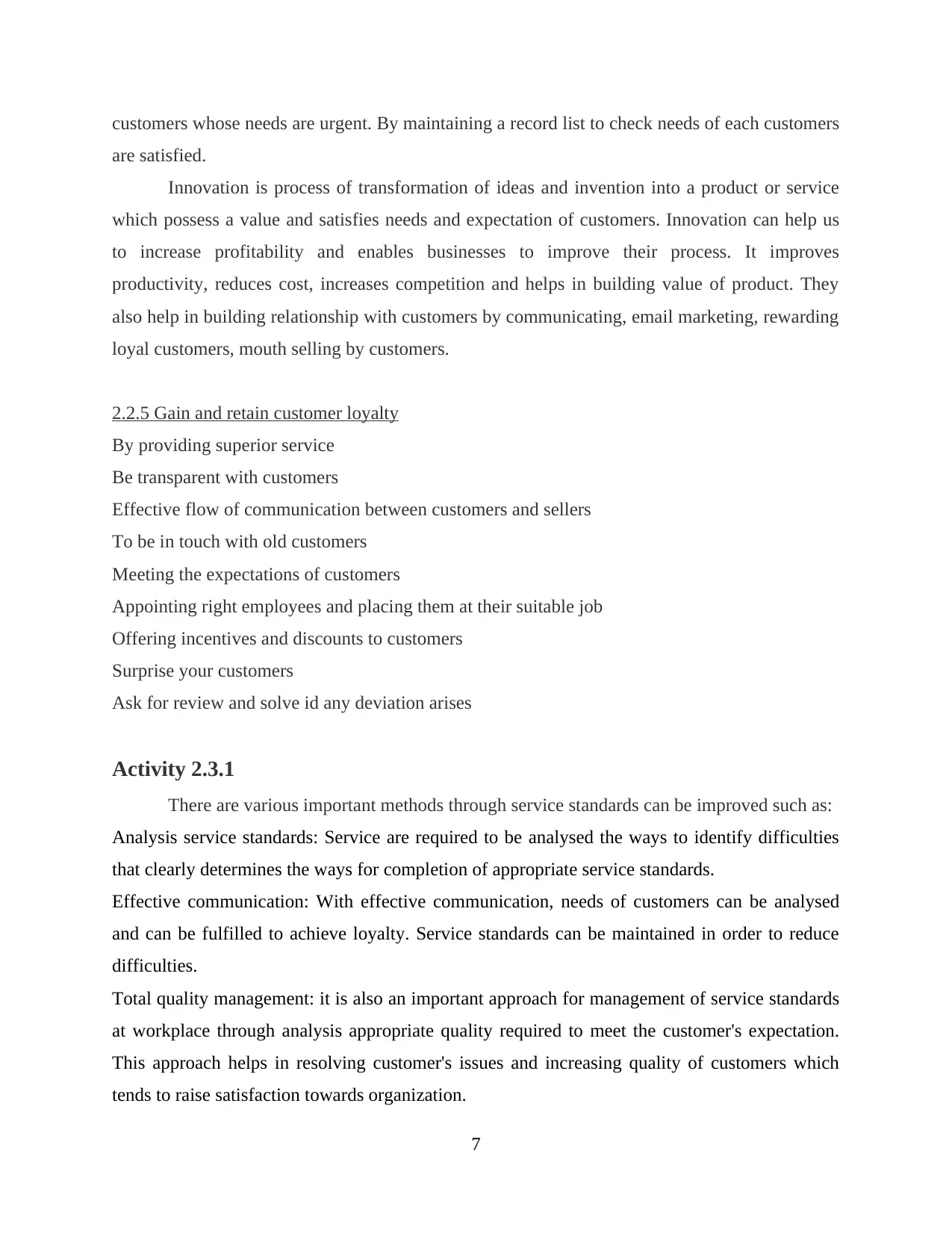
customers whose needs are urgent. By maintaining a record list to check needs of each customers
are satisfied.
Innovation is process of transformation of ideas and invention into a product or service
which possess a value and satisfies needs and expectation of customers. Innovation can help us
to increase profitability and enables businesses to improve their process. It improves
productivity, reduces cost, increases competition and helps in building value of product. They
also help in building relationship with customers by communicating, email marketing, rewarding
loyal customers, mouth selling by customers.
2.2.5 Gain and retain customer loyalty
By providing superior service
Be transparent with customers
Effective flow of communication between customers and sellers
To be in touch with old customers
Meeting the expectations of customers
Appointing right employees and placing them at their suitable job
Offering incentives and discounts to customers
Surprise your customers
Ask for review and solve id any deviation arises
Activity 2.3.1
There are various important methods through service standards can be improved such as:
Analysis service standards: Service are required to be analysed the ways to identify difficulties
that clearly determines the ways for completion of appropriate service standards.
Effective communication: With effective communication, needs of customers can be analysed
and can be fulfilled to achieve loyalty. Service standards can be maintained in order to reduce
difficulties.
Total quality management: it is also an important approach for management of service standards
at workplace through analysis appropriate quality required to meet the customer's expectation.
This approach helps in resolving customer's issues and increasing quality of customers which
tends to raise satisfaction towards organization.
7
are satisfied.
Innovation is process of transformation of ideas and invention into a product or service
which possess a value and satisfies needs and expectation of customers. Innovation can help us
to increase profitability and enables businesses to improve their process. It improves
productivity, reduces cost, increases competition and helps in building value of product. They
also help in building relationship with customers by communicating, email marketing, rewarding
loyal customers, mouth selling by customers.
2.2.5 Gain and retain customer loyalty
By providing superior service
Be transparent with customers
Effective flow of communication between customers and sellers
To be in touch with old customers
Meeting the expectations of customers
Appointing right employees and placing them at their suitable job
Offering incentives and discounts to customers
Surprise your customers
Ask for review and solve id any deviation arises
Activity 2.3.1
There are various important methods through service standards can be improved such as:
Analysis service standards: Service are required to be analysed the ways to identify difficulties
that clearly determines the ways for completion of appropriate service standards.
Effective communication: With effective communication, needs of customers can be analysed
and can be fulfilled to achieve loyalty. Service standards can be maintained in order to reduce
difficulties.
Total quality management: it is also an important approach for management of service standards
at workplace through analysis appropriate quality required to meet the customer's expectation.
This approach helps in resolving customer's issues and increasing quality of customers which
tends to raise satisfaction towards organization.
7
Paraphrase This Document
Need a fresh take? Get an instant paraphrase of this document with our AI Paraphraser
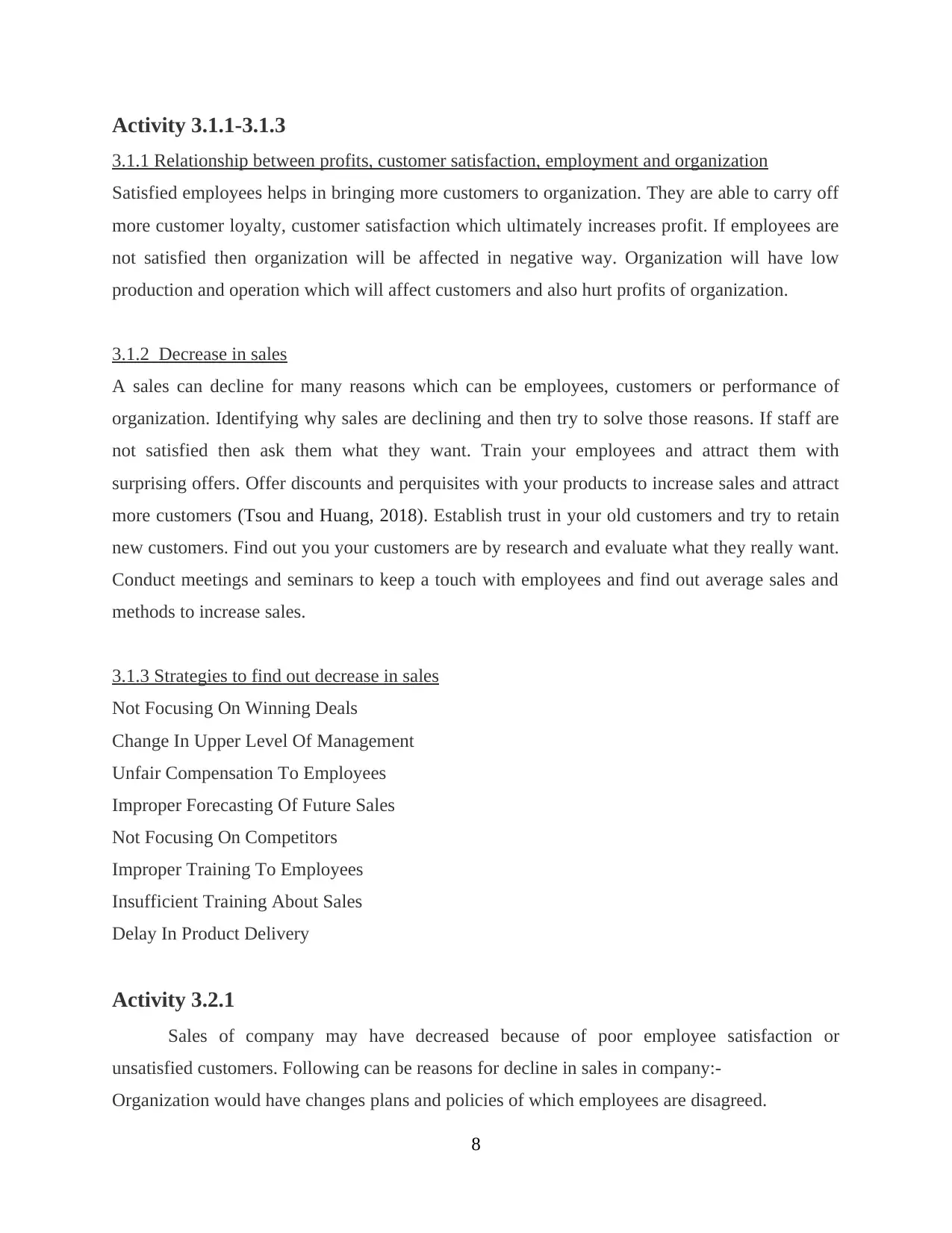
Activity 3.1.1-3.1.3
3.1.1 Relationship between profits, customer satisfaction, employment and organization
Satisfied employees helps in bringing more customers to organization. They are able to carry off
more customer loyalty, customer satisfaction which ultimately increases profit. If employees are
not satisfied then organization will be affected in negative way. Organization will have low
production and operation which will affect customers and also hurt profits of organization.
3.1.2 Decrease in sales
A sales can decline for many reasons which can be employees, customers or performance of
organization. Identifying why sales are declining and then try to solve those reasons. If staff are
not satisfied then ask them what they want. Train your employees and attract them with
surprising offers. Offer discounts and perquisites with your products to increase sales and attract
more customers (Tsou and Huang, 2018). Establish trust in your old customers and try to retain
new customers. Find out you your customers are by research and evaluate what they really want.
Conduct meetings and seminars to keep a touch with employees and find out average sales and
methods to increase sales.
3.1.3 Strategies to find out decrease in sales
Not Focusing On Winning Deals
Change In Upper Level Of Management
Unfair Compensation To Employees
Improper Forecasting Of Future Sales
Not Focusing On Competitors
Improper Training To Employees
Insufficient Training About Sales
Delay In Product Delivery
Activity 3.2.1
Sales of company may have decreased because of poor employee satisfaction or
unsatisfied customers. Following can be reasons for decline in sales in company:-
Organization would have changes plans and policies of which employees are disagreed.
8
3.1.1 Relationship between profits, customer satisfaction, employment and organization
Satisfied employees helps in bringing more customers to organization. They are able to carry off
more customer loyalty, customer satisfaction which ultimately increases profit. If employees are
not satisfied then organization will be affected in negative way. Organization will have low
production and operation which will affect customers and also hurt profits of organization.
3.1.2 Decrease in sales
A sales can decline for many reasons which can be employees, customers or performance of
organization. Identifying why sales are declining and then try to solve those reasons. If staff are
not satisfied then ask them what they want. Train your employees and attract them with
surprising offers. Offer discounts and perquisites with your products to increase sales and attract
more customers (Tsou and Huang, 2018). Establish trust in your old customers and try to retain
new customers. Find out you your customers are by research and evaluate what they really want.
Conduct meetings and seminars to keep a touch with employees and find out average sales and
methods to increase sales.
3.1.3 Strategies to find out decrease in sales
Not Focusing On Winning Deals
Change In Upper Level Of Management
Unfair Compensation To Employees
Improper Forecasting Of Future Sales
Not Focusing On Competitors
Improper Training To Employees
Insufficient Training About Sales
Delay In Product Delivery
Activity 3.2.1
Sales of company may have decreased because of poor employee satisfaction or
unsatisfied customers. Following can be reasons for decline in sales in company:-
Organization would have changes plans and policies of which employees are disagreed.
8
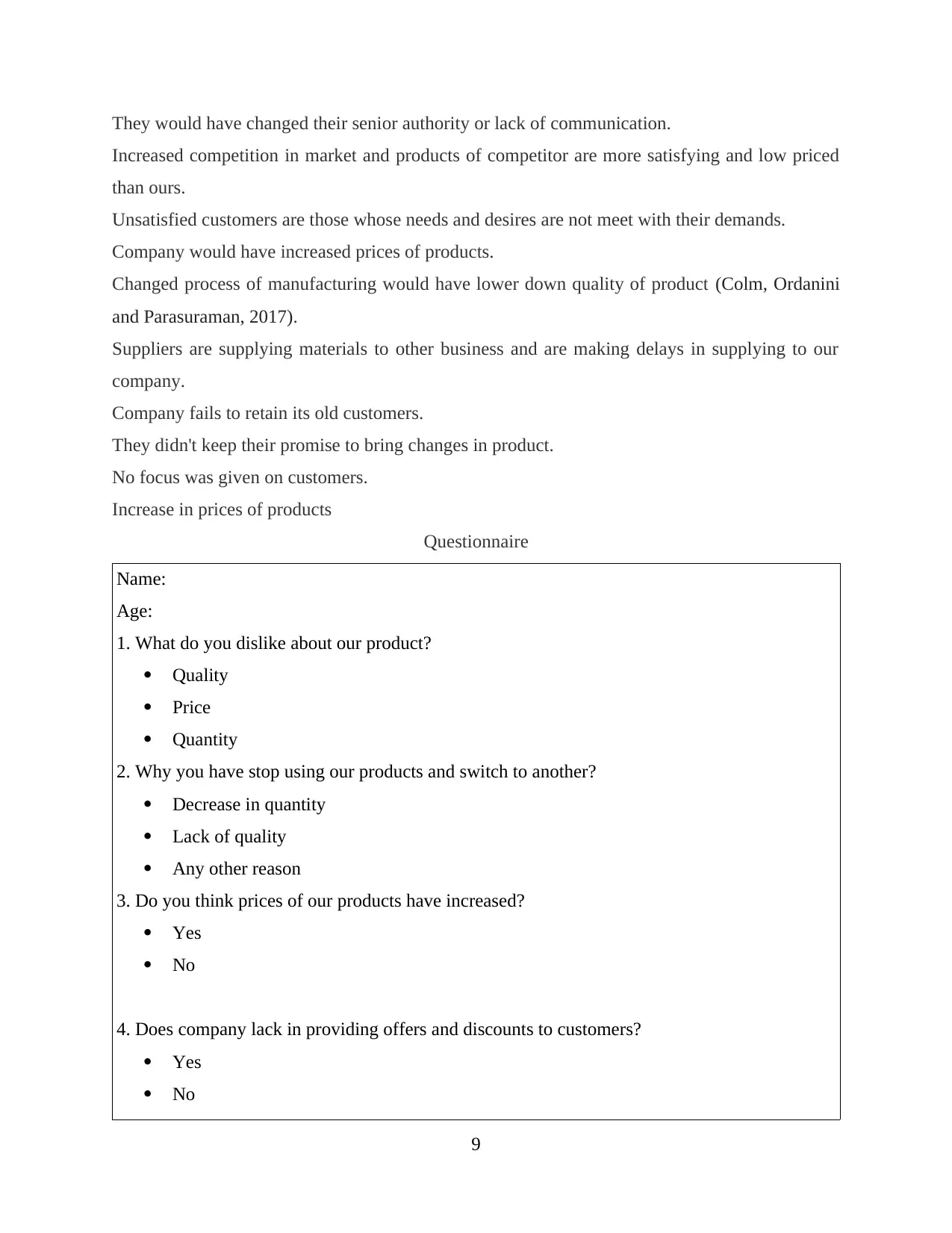
They would have changed their senior authority or lack of communication.
Increased competition in market and products of competitor are more satisfying and low priced
than ours.
Unsatisfied customers are those whose needs and desires are not meet with their demands.
Company would have increased prices of products.
Changed process of manufacturing would have lower down quality of product (Colm, Ordanini
and Parasuraman, 2017).
Suppliers are supplying materials to other business and are making delays in supplying to our
company.
Company fails to retain its old customers.
They didn't keep their promise to bring changes in product.
No focus was given on customers.
Increase in prices of products
Questionnaire
Name:
Age:
1. What do you dislike about our product?
Quality
Price
Quantity
2. Why you have stop using our products and switch to another?
Decrease in quantity
Lack of quality
Any other reason
3. Do you think prices of our products have increased?
Yes
No
4. Does company lack in providing offers and discounts to customers?
Yes
No
9
Increased competition in market and products of competitor are more satisfying and low priced
than ours.
Unsatisfied customers are those whose needs and desires are not meet with their demands.
Company would have increased prices of products.
Changed process of manufacturing would have lower down quality of product (Colm, Ordanini
and Parasuraman, 2017).
Suppliers are supplying materials to other business and are making delays in supplying to our
company.
Company fails to retain its old customers.
They didn't keep their promise to bring changes in product.
No focus was given on customers.
Increase in prices of products
Questionnaire
Name:
Age:
1. What do you dislike about our product?
Quality
Price
Quantity
2. Why you have stop using our products and switch to another?
Decrease in quantity
Lack of quality
Any other reason
3. Do you think prices of our products have increased?
Yes
No
4. Does company lack in providing offers and discounts to customers?
Yes
No
9
⊘ This is a preview!⊘
Do you want full access?
Subscribe today to unlock all pages.

Trusted by 1+ million students worldwide
1 out of 17
Related Documents
Your All-in-One AI-Powered Toolkit for Academic Success.
+13062052269
info@desklib.com
Available 24*7 on WhatsApp / Email
![[object Object]](/_next/static/media/star-bottom.7253800d.svg)
Unlock your academic potential
Copyright © 2020–2025 A2Z Services. All Rights Reserved. Developed and managed by ZUCOL.





